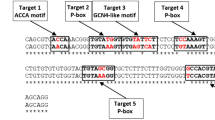Abstract
The synthesis of 5-aminolevulinic acid (ALA) is a key regulatory step for the production of hemes and chlorophyll via the tetrapyrrole synthesis pathway. The first enzyme committed to ALA synthesis is glutamyl-tRNA reductase encoded in Arabidopsis by a small family of nuclear-encoded HEMA genes. To better understand the regulation of the tetrapyrrole synthesis pathway we have made a detailed study of HEMA2 expression with transgenic Arabidopsis thaliana L. Col. plants carrying chimeric HEMA2 promoter:gusA fusion constructs. Our results show that the HEMA2 promoter directs expression predominantly to roots and flowers, but that HEMA2 is also expressed at low levels in photosynthetic tissues. Deletion analysis of the HEMA2 promoter indicates that a ca. 850 bp fragment immediately upstream of the HEMA2 coding region is sufficient to drive regulated gusA expression. In contrast to HEMA1, HEMA2 is not up-regulated by red, far-red, blue, UV or white light. In addition, elimination of a promotive plastid signal by Norflurazon-induced photobleaching of plastids had no effect on HEMA2 expression while being required for normal white-light induction of HEMA1. HEMA2 expression in the cotyledons is inhibited by the presence of sucrose or glucose, but not fructose, and this response is light-independent. HEMA1 expression in cotyledons is also inhibited by sugars, but in a strictly light-dependent manner. The roles of HEMA1 and HEMA2 in meeting cellular tetrapyrrole requirements are discussed.
Similar content being viewed by others
References
Arabidopsis Genome Initiative 2000. Analysis of the genome sequence of the flowering plant Arabidopsis thaliana. Nature 408: 796–815.
Argüello-Astorga, G.R. and Herrera-Estrella, L.R. 1996. Ancestral multipartite plant promoters have structural features correlating with specific phototransduction pathways. Plant Physiol. 112: 1151–1166.
Bougri, O. and Grimm, B. 1996. Members of a low-copy number gene family encoding glutamyl-tRNA reductase are differentially expressed in barley. Plant J. 9: 867–878.
Bradford, M. 1976. A rapid and sensitive method for the quantitation of microgram quantities of protein utilizing the principle of protein-dye binding. Anal. Biochem. 72: 248–254.
Elmayan, T. and Tepfer, M. 1995. Evaluation in tobacco of the organ specificity and strength of the rolD promoter, domain A of the 35S promoter and the 35S-2 promoter. Transgenic Res. 4: 388–396.
Higo, K., Ugawa, Y., Iwamoto, M. and Korenaga, T. 1999. Plant cis-acting regulatory DNA elements (PLACE) database: 1999. Nucl. Acids. Res. 27: 297–300.
Ilag, L.L., Kumar, A.M. and Söll, D. 1994. Light regulation of chlorophyll biosynthesis at the level of 5-aminolevulinate formation in Arabidopsis. Plant Cell 6: 265–275.
Jarvis, P. 2001. Intracellular signalling: the chloroplast talks! Curr. Biol. 11: R307–R310.
Jefferson, R.A., Kavanagh, T.A. and Bevan, M. 1987. GUS fusions: ?-glucuronidase as a sensitive and versatile gene fusion marker in higher plants. EMBO J. 6: 3901–3907.
Koch, K.E. 1996. Carbohydrate-modulated gene expression in plants. Annu. Rev. Plant Physiol. Plant Mol. Biol. 47: 509–540.
Kumar, A.M., Chaturvedi, S. and Söll, D. 1999. Selective inhibition of HEMA gene expression by photooxidation in Arabidopsis thaliana. Phytochemistry 51: 847–850.
Kumar, A.M., Csankovszki, G. and Söll, D. 1996a. A second and differentially expressed glutamyl-tRNA reductase gene from Arabidopsis thaliana. Plant Mol. Biol. 30: 419–426.
Kumar, A.M., Schaub, U., Söll, D. and Ujwal, M.L. 1996b. Glutamyl-transfer RNA: at the crossroads between chlorophyll and protein biosynthesis. Trends Plant Sci. 1: 371–376.
López-Juez, E., Jarvis, R.P., Takeuchi, A., Page, A.M. and Chory, J. 1998. New Arabidopsis cue mutants suggest a close connection between plastid-and phytochrome regulation of nuclear gene expression. Plant Physiol. 118: 803–815.
McCormac, A.C., Fischer, A., Kumar, A.M., Söll, D. and Terry, M.J. 2001. Regulation of HEMA1 expression by phytochrome and a plastid signal during de-etiolation in Arabidopsis thaliana. Plant J. 25: 549–562.
Murashige, T. and Skoog, F. 1962. A revised medium for rapid growth and bioassays with tobacco tissue cultures. Physiol. Plant. 15: 473–497.
Papenbrock J. and Grimm, B. 2001. Regulatory network of tetrapyrrole biosynthesis: studies of intracellular signalling involved in metabolic and developmental control of plastids. Planta 213: 667–681.
Tanaka, R., Yoshida, K., Nakayashiki, T., Masuda, T., Tsuji, H., Inokuchi, H. and Tanaka, A. 1996. Differential expression of two hemA mRNA encoding glutamyl-tRNA reductase proteins in greening cucumber seedlings. Plant Physiol. 110: 1223–1230.
Tanaka, R., Yoshida, K., Nakayashiki, T., Tsuji, H., Inokuchi, H., Okada, K. and Tanaka, A. 1997. The third member of the hemA gene family encoding glutamyl-tRNA reductase is primarily expressed in roots in Hordeum vulgare. Photosyn. Res. 53: 161–171.
Terry, M.J., Wahleithner, J.A. and Lagarias, J.C. 1993. Biosynthesis of the plant photoreceptor phytochrome. Arch. Biochem. Biophys. 306: 1–15.
von Wettstein, D., Gough, S. and Kannangara, C.G. 1995. Chlorophyll biosynthesis. Plant Cell 7: 1039–1057.
Wang, Z.-Y., Kenigsbuch, D., Sun, L., Harel, E., Ong, M.S. and Tobin, E.M. 1997. A Myb-related transcription factor is involved in the phytochrome regulation of an Arabidopsis Lhcb gene. Plant Cell 9: 491–507.
Author information
Authors and Affiliations
Rights and permissions
About this article
Cite this article
Ujwal, M., McCormac, A.C., Goulding, A. et al. Divergent regulation of the HEMA gene family encoding glutamyl-tRNA reductase in Arabidopsis thaliana: expression of HEMA2 is regulated by sugars, but is independent of light and plastid signalling. Plant Mol Biol 50, 81–89 (2002). https://doi.org/10.1023/A:1016081114758
Issue Date:
DOI: https://doi.org/10.1023/A:1016081114758




